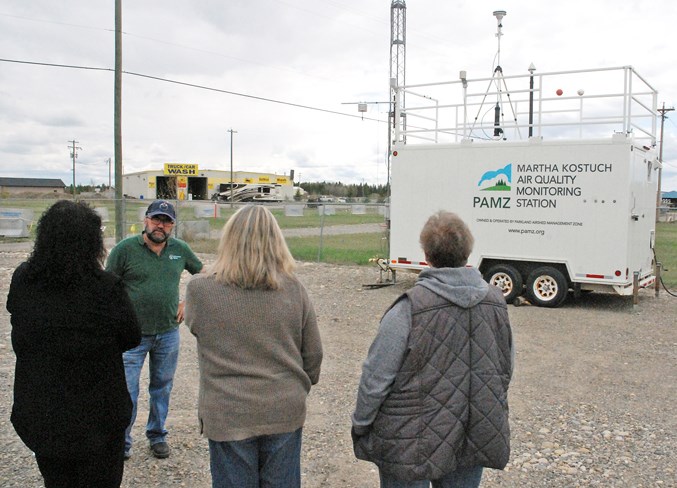At certain times of the year, Sundre can be susceptible to periods of lingering dust that exceed normal levels, a new report has found.
However, the amount of fine particulate matter hanging in the local atmosphere — which presents a greater danger to human health — tends to remain well within allowable averages, said Kevin Warren, Parkland Airshed Management Zone’s executive director.
The organization had set up an air monitoring station in Sundre following a previous request from the South McDougal Flats Area Protection Society.
The society is a platform for people in the area to voice their concerns about air, water, noise, safety, property values and quality of life, said society president Robin Tudor.
The report outlining the recent monitoring’s findings was presented to society members on Tuesday, Nov. 20 at the McDougal Flats Hall. About a dozen people attended including a town representative, said Tudor.
In the summer of 2016, the society requested the watchdog set up the monitoring station. PAMZ, which works by consensus, agreed the concerns were a high enough priority to justify spending some time sampling the air, he said.
Although initial air monitoring in May and September of 2017 did not reveal any exceedances, the station was not around to monitor when winds kicked up substantial amounts of dust that October, he said, adding PAMZ committed to again monitoring air quality in June, July and August of 2018.
But due to wafting smoke from forest fires, data from August was so skewed that the station was left in Sundre throughout September and October as well, he said.
Monitoring efforts during those subsequent months, which were not impacted by the forest fires, identified some exceedances in the levels of dust lingering in the air, he said. The findings presented in the PAMZ report stemmed from the months monitored in 2018.
The study compiled a large, comprehensive body of data that includes measurements such as humidity, wind direction, as well as fine and suspended particulate matter — the former being tiny particles not visible to the naked eye that can penetrate human lungs with ease causing health concerns. Suspended particulate matter is larger nuisance particles like dust that tend to settle or get safely filtered out by nose hairs before reaching the pulmonary system, said Warren.
Tudor noted that there was some construction occurring in the area combined with fairly low wind speeds during the periods when dust levels were exceeded. With dry conditions and calm winds when industrial traffic hauls gravel, the dust tends to just hang in the air, he added.
“Our concern is dust. We know it’s not there every day,” he said.
The situation is exacerbated when winds whip up dust and is even further compounded by periods of high industrial activity such as crushing, digging and hauling, he said.
“The common factor is the amount of open space.”
When a gravel pit is approved and extraction begins, the topsoil is first stripped to gain access to the aggregate underneath. In the absence of the surface vegetation, ideal conditions are created for dust from the exposed ground to kick up into the air, he said.
With several 20- to 30-acre pits in the general vicinity, the potential for dust grows, he said. The society has asked Mountain View County officials to minimize the amount of open land at any given time by completely reclaiming active pits before approving new ones.
“There should be a limit on how much should be open in the area altogether.”
Nobody can control the wind, he concedes, but greater efforts could and should be made to reduce the potential amount of dust from industrial activity.
Warren’s presentation was informative and fact-based on a large body of data that paints an accurate picture of the problem, which is dust, said Tudor.
“My fear is the people it’s presented to will brush off the information.”
Although PAMZ is not expected to return to Sundre with its air monitoring station any time in the foreseeable future, Tudor said the organization was able to demonstrate levels of dust that exceed Alberta Environment limits do at times occur in the area.
“It’s something man-made — not a forest fire, not a blizzard. Definitely man-made.”
Warren said a different methodology was employed this year, consisting of round-the-clock monitoring that made hourly averages available as opposed to 24-hour averages that were compiled in 2017.
“We monitored a whole host of pollutants aside from suspended particulate and fine particulate matter,” Warren said.
“Levels of other pollutants are within the range to be expected for a town the size of Sundre.”
But earlier in September as well as throughout most of October, the air quality watchdog noted about 13 times when the daily air quality objective for total suspended particulate matter was exceeded, he said, adding levels of fine particulate matter remained within allowable averages.
“The general air quality is good,” he said.
“If we exclude total suspended particulate matter, levels of other pollutants are within the normal ranges for similar-sized towns.”
But there are levels that exceed air quality objectives. He said that is something that should attract the attention of Alberta Environment, which has the report, as well as industry stakeholders who operate in the area and the town and county councils.
“They should all be interested in that.”
The only time exceedances were observed in all objectives — fine as well as suspended particulate matter — was during the fallout from the wildfires, he said.
Warren is scheduled to present the study’s findings to county officials on Dec. 5. PAMZ presents and makes available information from its studies, but any decisions on future courses of action are up to the provincial and municipal governments, he said.



